Editor’s Note: This text course is an edited transcript of a live webinar. Download supplemental course materials.
Learning Objectives
Dr. Laurel Christensen: Our learning objectives today are as follows: After this class, you will be able to describe the product features of the LiNX2, describe two benefits of the new audiology features that are in the LiNX2 device, and describe two benefits of new connectivity features.
LiNX
ReSound LiNX™ has been very successful. Its sound quality has been top-rated by independent studies. We also added the Made for iPhone component when we launched the ReSound LiNX. ReSound LiNX2 takes smart hearing to the next level.
When you think about the features and signal processing of hearing aids today, you have to think about a whole hearing system. You are doing a disservice to the end user if you do not consider the rest of the technology that is available today, such as wireless connectivity to TV and streamers, mini microphones or phone compatibility for more effective communication. Take a mini microphone, for example, that works in situations where a hearing aid will have limited benefit, such as in environments with poor signal-to-noise ratios. Connectivity to telephone and accessories is an important consideration in today's hearing aids.
Design of the hearing aid is also important. This includes comfort in the ear and the overall feel of the hearing aid to the user. Lastly, we should consider apps. These are starting to emerge in hearing aid technology and are a wonderful addition to hearing health care. These apps give the end user a little more control so they can have more success in more environments. We took these four cornerstones into account in developing LiNX2.
LiNX2 Product Line
LiNX2 is a complete family of products, from custom shells to receiver-in-the-ear (RITE), to standard behind-the-ear (BTE) styles (Figure 1). As an advancement, Ear-to-Ear will now be available in some of our custom products. Made for iPhone will be available in all of our custom products down to an in-the-canal hearing aid. The LiNX2 lineup has completely redesigned hardware, including the new faceplates for our custom products and all of the BTEs.
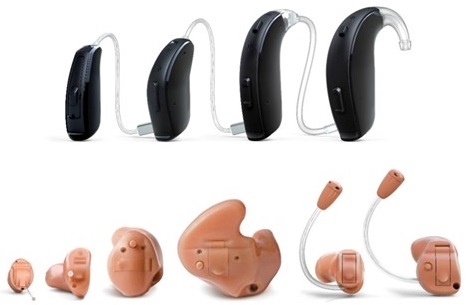
Figure 1. ReSound LiNX2 product family.
We now have a size 13 receiver-in-the-ear (RITE) product. This product provides the cosmetics and battery life that many of your patients are looking for. The two RITE products in this product line have a new three-pin receiver system and all-new dome system, which I will show later in this presentation.
We have added Spatial Sense as a new feature in our LiNX2 9 series. We already have superior sound quality, and we are making it even better. We also added some localization cues that hearing aids traditionally do not preserve.
The next audiology feature is Tinnitus Nature Sounds. In all of our LiNX2 products, we will have Tinnitus Nature Sounds and the Tinnitus Sound Generator, which was previously only available in our tinnitus-specific products.
We offer connectivity to all of our accessories and have a new app called Smart App with new features, available for Android as well.
The following movie shows the size 13 battery receiver-in-the-ear product. You can see the microphones, push button, battery door, and new receiver and dome system. This has a very high quality feel in the hand, and outstanding cosmetics when fit on the ear, as compared to other size 13 RICs.

We have left no detail untouched. In the custom products, we have Synchronized Acceptance manager. That is an Ear-to-Ear communication algorithm where we start a patient at a comfortable gain level and then work them into a prescriptive target for intelligibility over time.
LiNX2 has multiple power levels. In the ultra-power models, we are adding features that we already have in our super power hearing aid, the ENZO. Likewise, we have added our ultra-power receiver offerings for our RITE products. One of those features is a low-frequency boost. We now have the option of doing linear and semi-linear types of fittings with the compression that you would expect. Essentially, we are opening up the fitting line for the severe to profound hearing losses so you can have the linear and loudness boost, with all the things that you would want and expect in our custom products in our ultra-power receiver and ENZO.
Custom Products
In our custom products, you will find Telecoil and wireless functionality. The new Smart App will now support all custom devices that have the MFi connection down to the in-the-canal (ITC) hearing aid. The ReSound Control App will also be compatible as before through the Phone Clip. If your patients does not have an iPhone or an Android phone that is compatible with our Android app, they can use any phone that they would like using the Phone Clip.
SureFit Receiver Portfolio
The new receiver system is called it the SureFit receiver system. The receivers themselves are silver and cosmetically high end (Figure 2). There is a low-power receiver, which is smaller than our current slim receiver, but it has more gain than the slim receiver. The medium-power receiver is replacing what we used to call our normal-power receiver. It also has more gain and is smaller than the normal-power receiver. The high-power receiver is smaller than the current high power that we have on the market, but the gain is about the same. We will continue to offer the ultra-power receiver that is offered already with LiNX. Any time you use the ENZO super power hearing aid or an ultra-power custom product, you can open up all of the features for fitting severe to profound hearing loss with the ultra-power receiver.

Figure 2. New SureFit receivers.
With the new receivers come new domes. The new domes are an opaque gray. They are discreet in the ear because they create a bit of a shadow effect. They also look nicer than clear or white domes for ear wax accumulation. These are all interchangeable with the receivers that we have today.
We nano coat our receivers and our hearing instruments inside and out. This coating on the receivers is important because the receiver is the most susceptible to moisture and failure. It makes the hearing aid more robust and reliable. Figure 3 shows some comparisons of nano-coated and non-nano-coated receivers.
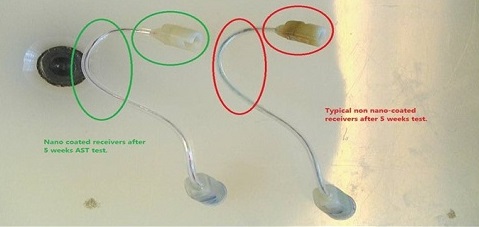
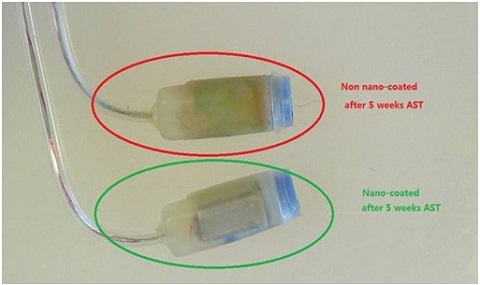
Figure 3. Nano coated receivers (green) compared to non-nano-coated receivers (red) after 5 weeks’ time.
To my knowledge, we are the only company to nano coat receivers. We do not just have one product that is water resistant; our entire product line is water resistant.
Top-Rated Sound Quality: Surround Sound by ReSound
I mentioned earlier in the presentation that we have top-rated sound quality, but let’s address specifically what makes it highly rated on independent studies.
We use a warp-based compression system. It is based upon a warping system rather than fast Fourier transform (FFT) or a filter banking compressor. The benefits of a warp system are that it is very fast with low-distortion compression. It is a nice starting place on which to build the rest of our sound processing. It has wide dynamic range compression (WDRC) through the entire frequency range, unless you are using one of our ultra-power options, where you can go to linear to semi-linear.
DFS Ultra
DFS Ultra is our feedback suppression system. It gives robust gain before feedback and good sound quality. We do have a music mode that can be used for people who might be listening to a lot of music, such as musicians or singers, who want the cleanest sound quality they can get without any feedback.
Binaural Directionality II
The next feature is Binaural Directionality II with Spatial Sense. Binaural Directionality II is available in LiNX2. It is the way that we steer our directional microphones to give patients the best hearing in noise and with the ability to hear everything else around them. Spatial Sense is available in the LiNX2 9-level products, enhanced with the best sound quality and localization possible. We offer all of the directional options previously available in LiNX 9 in the LiNX2 7-level products. Natural Directionality will now be in the 5 level products.
Noise Tracker
Another feature is Noise Tracker, our noise reduction system that is based on spectral subtraction. It works when the background noise is speech. Many other systems do not work when the background noise is speech. It is something that is easily testable in a test box, and ours uses a system that works well if they are in a restaurant or when the background noise is speech.
Environmental Optimizer II
Next is Environmental Optimizer II. This allows considerable automation of the system, including volume control settings in our seven different environment classifications. This is a nice feature to give someone who needs very strong noise reduction in noisy environments without a lot of speech, but it brings it back down to a milder setting when there is speech in the environment with some noise. If you turn noise reduction up too high for patients, they tend to complain about hearing aids fading in and out. It often is that the noise reduction is taking out the audibility of speech because it is set too high for every environment. Being able to automate the noise reduction in the seven environments is a good feature for patients.
Sound Shaper
Sound Shaper, which is frequency compression, is available in the LiNX2. Frequency compression is not defaulted “on” in our products; the research today does not support that. We want the clinician to make that decision and if they do not need frequency compression, then we would like the patient to get the full bandwidth. However, the option is there for patients who need it.
Tinnitus Sound Generator
Next is Tinnitus Sound Generator, which can be activated in any LiNX2 product. You also have the option to turn on Nature Sounds in the instrument in a different memory.
Ear-to-Ear
You have your Ear-to-Ear communication that you would expect. Push one button in one ear and the program or volume will change on the other side. All of the Ear-to-Ear communication for convenience would be there also. We also have the direct audio and data streaming. All of the streaming from the phones and our accessories would also be in LiNX2.
Sound Quality
Let’s talk a little bit about the sound quality study. There is an independent lab in Denmark called DELTA. They approached the six major manufacturers and asked us for our top-end hearing aids at the time, asking if they could do an evaluation of the sound quality using a test that had been found to be reliable and valid. All the major manufacturers agreed.
They used hearing impaired subjects with mild to moderate sloping hearing loss, who ranged from 64 to 80 years. They rated the sound quality in seven different environments. They had female speaker, male speaker, speech babble, pop music, kitchen work (which is forks, knives, and plate noise), moderate traffic noise and a small spring or running water in a forest. They had to say which ones they liked most and least. They were pitting the hearing aids against one another and asked the subjects to rank them on bass, treble, naturalness, and reverberation. It was a very long study so the subjects could rate all six hearing aids.
There were two hearing aids out of six that were rated quite well in the study, one of them being ReSound, and four hearing aids that were rated not quite as well. At the time that the results came out, we were using the ReSound Alera hearing aid. All the manufacturers had put out new hearing aids at this time, so we asked for the study to be repeated with the newer hearing aids, which for us, was the Verso.
ReSound was ranked again at the top for sound quality. Surround Sound by ReSound is something that we will keep building on, as we will do with Spatial Sense in the LiNX2 launch. We are very happy with patients’ report about the sound quality when they are moved from one brand of hearing aids into ReSound.
Surround Sound by ReSound is what we call all of the signal processing that goes into our hearing aids. Our philosophy is to do everything we can to emulate the natural hearing experience of someone who has normal hearing. We imitate the human ear and then take full advantage of the brain’s ability to process sound.
Binaural Directionality II with Spatial Sense
We have had Binaural Directionality for a long time, but now it is enhanced with Spatial Sense. Take a look at this scene.
In a picnic setting around a campfire with family, you can imagine that there is good conversation along with a lot of noise going on. There is no way to know what the signal of interest to the hearing aid user might be. At one minute, the signal of interest to him might be the woman sitting next to him, and sometimes it might be the man sitting across from him. Furthermore, these people could be moving around at any given moment.
At ReSound, we think that directionality in the hearing aids is not smart enough or fast enough to switch to exactly what the patient wants to hear at that time. First of all, a hearing aid has no idea what the hearing aid user wants to hear. Trying to switch directional beams around into different locations when it takes time to make that directional switch is probably not a good way for a hearing aid user to hear in this environment.
Let’s talk about directionality in general. In a laboratory, a listener sits in the center of the booth facing a speech signal with noise in the back. These environments are very controlled. The problem is that the world is not a laboratory.
The real world looks more like Figure 4. There are people and competing sounds all around, including right in front of the listener. What about sitting at a counter with someone to your right or left with people speaking to you in the front and all the kitchen noise in the background? I want you to think about what an automatic-steering directional hearing aid would do in this situation. These hearing aids make steering decisions based upon the loudest speech in the environment. The hearing aids are stuck in these environments, but if nothing else, they are pointing directional beams straight forward, making it very difficult for the hearing aid user to hear what is on the right and the left in the real world.




Figure 4. Real-world restaurant environment.
In a family situation, the speaker of interest will change repeatedly, as will the noise source and location. The hearing aids need to function in a way that the hearing aid user can attend to whatever they want at any time.
A directional hearing aid that has a beam of two directional microphones pointed left or right or front or back is very limiting. This limits to what the patient can hear and makes unilateral choices of what the patient is going to hear.
Automatic Directional Steering
There are some things that are not well understood about these automatic steering systems. What do you think happens when the hearing aid user starts speaking? You have speech coming dead center out of the hearing aid user’s mouth. Is that not the loudest modulated speech in the environment? That is what these automatic steering systems use to steer the directional beam. If the person is speaking, the hearing aid is going to steer both directional beams forward.
Think about a taxicab situation where the driver is a hearing aid user. Someone gets in the back of the taxi and says, “Could you please take me to the Hilton hotel?” Not enough time has gone by in order for these automatic directional steering systems to have turned the directionality to the back. Then the taxi driver says, “Sure. Which Hilton would you like to go to?” Whatever the driver says now changed the whole thought process inside those hearing aids and steered the directional beam back forward.
These automatic steering systems, even if they are picking out the correct signal of interest to that hearing aid user, only work if the hearing aid user does not speak. The minute the hearing aid user speaks, they are going to steer in a different direction. I think we have to give a lot of thought whether or not steering the directionality around constantly is the right thing to do for our patients to hear in different environments.
We think about this differently at ReSound. We have binaural directionality which analyzes the environment, exchanges data between the two ears, and when the sound in the environment is below 65 dB SPL, has two omnidirectional settings. Those omnidirectional microphones will stay that way until there is noise in the background. When noise is detected in the background, one directional microphone will turn on, and a directional microphone will activate on the side that is detecting the most noise. Directional microphones are there to attenuate the noise to the sides and to the back. You do not need to turn two directional microphones on to get the same benefit in the vast majority of situations.
What this microphone configuration allows you to do is still monitor the environment while looking at the person you want to hear. You get the 3 to 4 dB signal-to-noise ratio improvement that is provided by the directional microphone. Many studies have been done on these asymmetric fittings showing that we do not need two directional microphones activated to get the same benefit. This arrangement is closer to what occurs naturally for people with normal hearing.
We will shift the microphone to the other side using Ear-to-Ear communication when the noise shifts. If more noise starts to come up from the left side, we will switch it. If the noise is coming from the back and the speech is coming from the front, which is the situation where you are going to do better with two directional microphones, we will switch to binaural directional microphones in that case. This is how a normal hearing person hears in an environment. They survey the environment and choose to attend to what is of most interest, and they can shift their attention among different speakers. We do not allow that in hearing aids that have two directional beams in every directional setting. This approach tries to give people more of a normal hearing experience.
In Binaural Directionality, which is in the 7-level LiNX2, when you turn on two directional microphones for binaural directionality, those microphones will provide signal-to-noise ratio improvements as long as the signal of interest is in front of the listener and the competing signal is to the sides or to the back. Then we will have the asymmetric directional fitting. One microphone is directional and the other is omnidirectional. In that case, awareness and audibility comes from sounds that are not in front, and you will be able to hear whatever you want by just looking at that person.
Spatial Sense
Spatial Sense is added in the omnidirectional mode. The hearing aids are in omni/omni 70 to 80% of the time, but they change into different binaural directionality microphone configurations as the noise increases.
There are two things that we hope to accomplish with Spatial Sense. One is pinna restoration and the other is bilateral compression. We do this because BTE and RIE models have microphones above the pinna, and thus spectral pinna cues are removed. Second, BTE and RIE models have microphone placement that distorts interaural level difference (ILD). Third, WDRC that is independent in right and left devices can distort the ILD.
BTE and RIE hearing aids have become the highest percentage of hearing aids that are fit today. The microphone sits on top of the ear in those situations. The pinna provides a bit of forward directionality, resonances, and localization, especially front/back localization. When we move the microphone above the pinna, we take away all of those pinna effects. The first thing Spatial Sense will do is restore those pinna effects for BTE and RITE models.
The second piece to Spatial Sense is the preservation of the interaural latency difference. In any listening situation, sound will arrive at one ear first and at the other milliseconds later. The sound that arrives at the first ear will be louder than the second ear. With traditional WDRC in hearing aids, we give more gain to the softer ear and take out that level difference that is especially helpful for high-frequency localization. We have the pinna restoration and the bilateral compression, all called Spatial Sense, in our LiNX2 9-level hearing aids.
Hearing in space is not something we talk about much with our patients. However, our patients are perceiving, for the most part, hearing in the center of their head. We are used to listening to things outside our head, not inside our head. If you do not have the ability to locate the sounds that are around you, everything sounds like it is in your head.
For those readers who are visual learners, Figure 5 shows heat-related spectral characteristics plotted by frequency, amplitude and azimuth. The head of the person in shown in the middle, and you should know that the left ear is plugged, so only the right ear is measured. We circle sound, different frequencies, 360 degrees around the head. The red in this spectral characteristic is the loudest, which makes sense if the left ear is occluded. On the left, softer sounds are head shadowed as indicated in blue; the bluer it is, the more it is shadowed. You can see how much head shadow is created there.
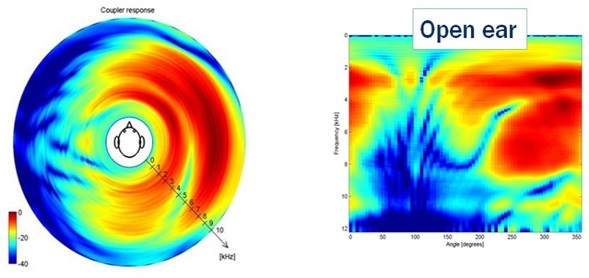
Figure 5. Spectral characteristics around the head, where red is the loudest and blue is the softest.
Another way to look at this is in Figure 6. Across the X axis is the angle, from 0 to 360. Frequency is plotted on the Y axis, with the lowest frequencies on the top and the highest frequencies are on the bottom. This is the pinna effect, 360 degrees around, if we measure what it does at different frequencies. Contrast the open ear with a BTE and then with Spatial Sound. You can see how Spatial Sound compensates for the pinna effects.

Figure 6. Spectral comparison of open ear, BTE and Spatial Sound.
Localization
Localization comes from two different cues: timing differences and intensity differences. The low frequencies lend more to the timing cues and the high frequencies lend more to the intensity cues.
An example is shown in Figure 7. Sound is coming from the loudspeaker on the left and it is arriving 70 dB SPL at the left ear and 60 dB SPL at the right ear. There is a 10 dB difference in the interaural intensity. What would we do in a normal WDRC hearing aid? We would give more gain to the 60 dB at the ear that is further away. We would give perhaps 10 dB there and only 5 dB to the other ear. Now we have 75 dB and 70 dB, and we have distorted the ILD. It was 10 and our hearing aids have made it 5. We have made it harder to localize.
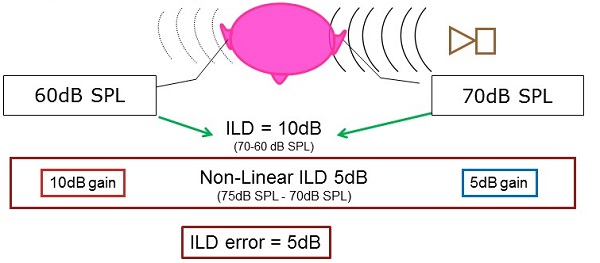
Figure 7. Example of ILD calculation and assignment of gain.
What should we do instead? We should take that sound at the softer ear and give it less gain. We are going to give it the gain that would be given to the louder ear. We are going to give each ear 5 dB and keep that ILD. We only do this when we know that the sound is arriving significantly reduced at one ear or another. If the sound comes into both ears at the same level, we know that that sound is likely from the front or from the back.
Evidence
Data showing localization with and without Spatial Sense is shown in Figure 8. What is plotted here is the number of localization errors. There are more errors in front-back localization which is indicated with the red bars. The gray bars are localization from all around. You can see that those confusions are also reduced with Spatial Sense.

Figure 8. Localization comparisons with and without Spatial Sense. The red bars indicate front-to-back localization, and the gray bars are all-around localization.
Tinnitus Sound Generator
Tinnitus Sound Generator is available in our LiNX2 products and can be turned on at any time. It is a traditional sound generator, but it is everything that you would need for doing different tinnitus treatment. You can change the cut offs and modulate the sound. What have also added nature sounds to LiNX2. They are water-inspired environments like the ocean, breaking waves, calming waves, beach surf, shoreline, and water creek. These are calming sounds that you can set up as an independent memory. The advantage is that they can use it in the hearing aid; it is not a separate device.
We have a new app, ReSound Relief. It can be used with anything, but if it is for a Made for iPhone, you can be streaming direct from the Relief app. Using our mini mic, you can stream any sound into the hearing aids that you would like to use for tinnitus treatment. This is probably the most flexible tinnitus solution on the market today with all of the different options of connectivity, which is available in custom products and BTEs alike.
You can stream from any audio source. You can use this with any phone with our Phone Clip. You will not need the Phone Clip, however, when you are using an iPhone.
Smart App
We already have an app that can be used for Google, Android phones and iPhones. For Android phones, you can use the remote control functions on the app without the Phone Clip. The Phone Clip is only used with the Android phone to take a phone call or stream music. With an Apple phone, everything goes directly into the hearing aids.
The beauty of apps is that we can update them as time goes on. We have added some features especially for your LiNX 9 fittings, but these features are only available for the patient if you, as the dispenser, decide to make it so. The way you program the hearing aids will determine whether or not these features are open to the user.
The first feature is called Speech Focus. This would be useful when patients are in a restaurant setting. It is a setting that will automatically enable two directional microphones. Speech Focus adjusts the width of the directional beam. You can have a wide width or a narrow width. Some other companies do this automatically, but we give the control to the patient; they decide if they need to zoom in on something more. In Binaural Directionality II with Spatial Sense, they are not going to need to do a lot for most environments, but as the signal-to-noise-ratio gets worse for the patient, they may want to add a little more.
They will also be able to adjust comfort in noise. Essentially, this increases or decreases the noise reduction settings. Certainly for comfort, it is nice to have high levels, but if it is too much noise reduction, it can compromise speech intelligibility. Having the ability to adjust it will make that patient even happier in environments where they are having trouble.
The third option for patient control is wind noise reduction. They will be able to decide if they need more wind noise reduction or less wind noise reduction. As I said, these are only in the LiNX2 9 models, and only if you would want your patient to have that kind of control.
Conclusion
The updated features and connectivity in LiNX2 make it a product that is beneficial to a variety of patients. This complete product family offers a premium hearing aid experience with proven sound quality. Please contact your ReSound representative if you have questions or would like more information.
Cite this Content as:
Christensen, L (2015, May). The next generation in Smart Hearing. AudiologyOnline, Article 14036. Retrieved from https://www.audiologyonline.com


